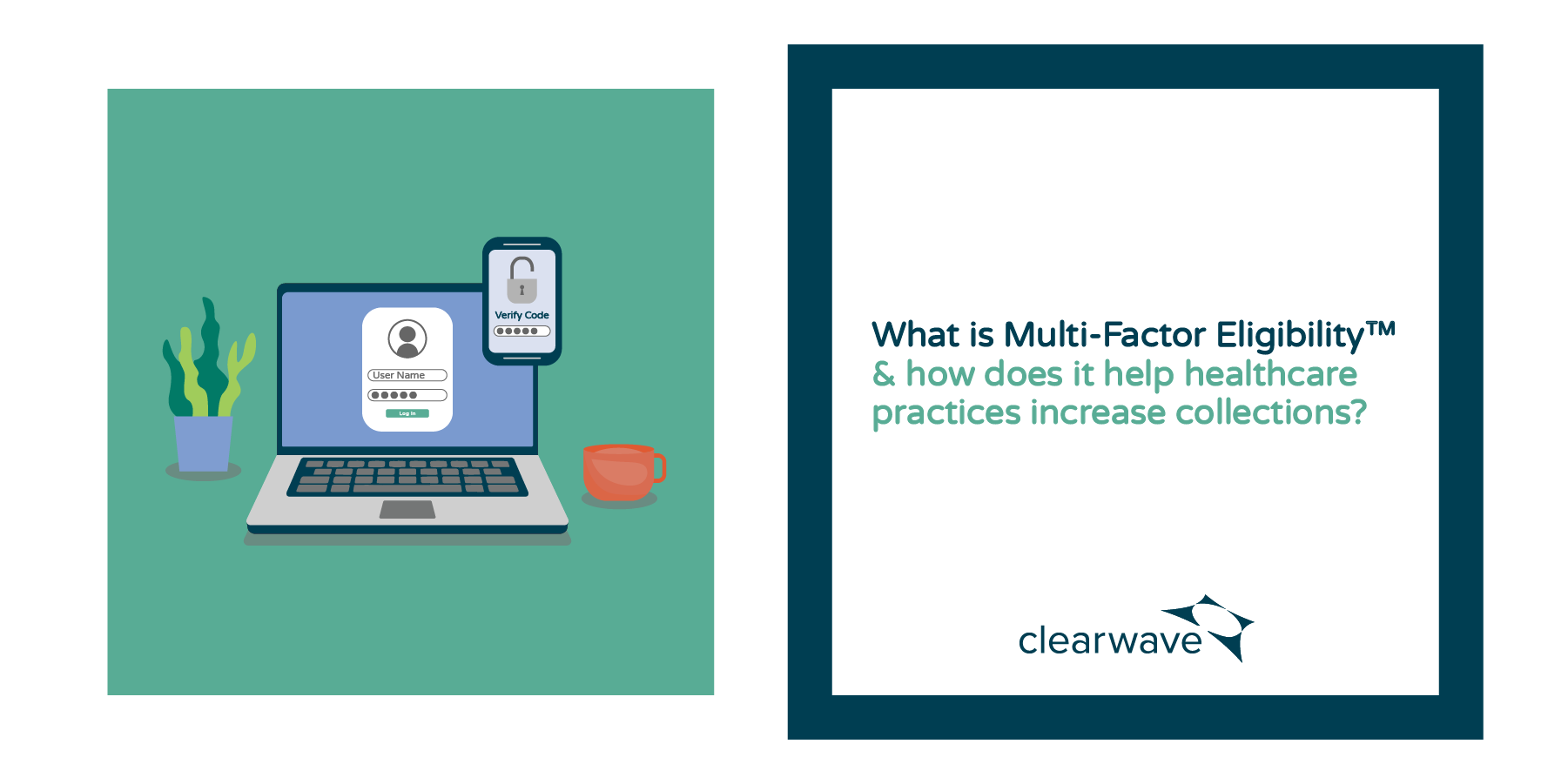Everything Your Need to Know About Patient Eligibility & Increasing Collections

One of the most significant hurdles practices face is accurately verifying patient insurance eligibility and collecting payments in a timely manner. Traditional methods, such as manual eligibility verification processes and limited software solutions, often fall short, leading to a host of problems that can hinder a practice’s financial success.
Inaccurate insurance information, overburdened staff and missed chances to collect payments at the point-of-service are just a few of the issues that can arise when practices rely on outdated eligibility verification strategies. These challenges can result in mounting bad debt, frequent claim rejections and a revenue cycle that feels like an uphill battle.
High-growth practices are leaning towards a new, cutting-edge solution t0 break free from these obstacles and unlock their true revenue potential: Multi-Factor Eligibility™ verification. This revolutionary approach to automated patient insurance verification is changing the game for practices, allowing them to streamline their financial processes, increase collection rates and secure their financial future.
Keep reading to learn more about Multi-Factor Eligibility™, including how it can help healthcare practices increase collections!
What is Multi-Factor Eligibility?
In the world of healthcare, ensuring accurate patient insurance eligibility verification is crucial for the financial well-being of practices. A multi-factor eligibility™ verification tool goes beyond the common automated eligibility verification tools you get from your practice management system or simplified patient engagement solutions. A multi-factor eligibility tool automatically verifies insurance at every critical patient interaction, from scheduling to check-in and beyond, all to ensure coverage has not lapsed and without added fees per transaction. As a result, your practice never has stale insurance data and can spot and correct errors faster, enabling them to collect accurate payments when a patient checks in.
Unlike simple, automated insurance verification, which typically checks eligibility 1-3 times and might use outdated or limited data, multi-factor eligibility verification employs a more dynamic approach. It verifies insurance up to seven times on average at different patient interaction points and extracts detailed information that’s relevant to your speciality. This method not only reduces the risk of errors and claim rejections but also ensures that the data is current and comprehensive, helping practice staff save hours on the process.
How Does Multi-Factor Eligibility Work?
Multi-factor eligibility software automatically verifies patient insurance at critical touchpoints, such as scheduling, pre-check and in-office registration. By pulling data from multiple clearing houses and hundreds of payers, this technology ensures that practices always have the most up-to-date information. Additionally, eligibility can be re-run at any time without incurring extra fees, allowing practices to maintain accuracy for post-billing claim submissions.
What Happens When You Don’t Verify Patient Eligibility Multiple Times?
When it comes to automatic insurance verification you have options. They are not all one in the same. Without true 7x multi-factor eligibility, you face common issues like:
- Too little, too much or nothing collected at check-in.
- Stale data leading to claims rejections and billing errors.
- No way to quickly identify patients with new coverage.
- Inability to detect duplicate patient records.
- Higher staff intervention & increased training time/costs.
- No clear way to highlight insurance discrepancies.
- No automatic matching of correct co-pay to patient accounts.
- No way to automatically check self-pay against Medicaid.
What Are the Benefits of Multi-Factor Eligibility?
Multi-factor eligibility offers a wide range of benefits that can transform the way healthcare practices operate.
Accelerated Payment Collection
Multi-factor eligibility enables practices to identify and collect accurate co-pays prior to or at the point of service. With a solution that not only verifies insurance and co-pays multiple times before the patient’s appointment, but also matches and inputs the correct co-pay amount to patient accounts — you can drastically reduce manual errors and future refunds or co-pay collection efforts. This proactive approach to payment collection accelerates the revenue cycle, reducing the need for costly and time-consuming post-service billing efforts.
Streamlined Patient Check-In Process
Multi-factor eligibility streamlines the patient check-in process by removing the time it takes for staff to verify insurance benefits during check-in. Instead, when patients arrive, your practice will know exactly what’s do and what information they may need to collect from the payment, without having to make additional verification. As a result, staff intervention in check-in drops dramatically and patients breeze through, getting to their exam room in seconds.
Enhanced Financial Clarity for Patients
In an era where patients are increasingly invested in their financial journey and healthcare costs, multi-factor eligibility empowers practices to provide clear and accurate financial information upfront. By leveraging precise insurance data, practices can engender trust and foster better relationships with their patients.
Create Staff Efficiency and Cost Savings
With a multi-factor eligibility tool and dashboard, staff no longer have to confirm benefits on a patient-by-patient basis or review the lengthy insurance details provided by other automated tools. With the presentation of data and simple flagging system provided in a multi-factor eligibility dashboard, staff can seamlessly narrow their focus only on the patients with insurance discrepancies that require their attention — dropping verification workloads by hours. This centralized scheduling view removes the need for staff to toggle between multiple payer portals or patient accounts. With time saved, practices can reallocate staff resources and FTE spending to other areas and get more value from these roles..
Minimized Claim Rejections and Resubmission Work
Multi-factor eligibility significantly reduces the risk of human error in the insurance verification process. By ensuring the accuracy and completeness of insurance information, practices can minimize claim rejections and the associated costs of reworking and resubmitting claims. In fact, practices using multi-factor eligibility solutions have seen a 94% drop in claim rejections! As a result, billing staff spend less time on claim resubmissions and in return can focus more of their time on complex claim denials or modifications to help your practice increase revenue in other ways, while dropping costs and workloads.
How Can Multi-Factor Eligibility Help Your Practice Increase Collections?
Multi-factor eligibility is a game-changer for healthcare practices looking to increase collections. By providing accurate, real-time insurance information, practices can collect the correct amounts at the point of service, reducing post-service collection challenges like refunds and credits.
Multi-Factor Eligibility helps practices identify patients with high deductibles, enabling them to have proactive financial discussions and set up payment plans when necessary.
This approach not only improves patient satisfaction by avoiding unexpected bills but also increases the likelihood of timely payments.
Do you want to learn more about how Multi-Factor Eligibility™ can help your practice? Schedule a Demo today




